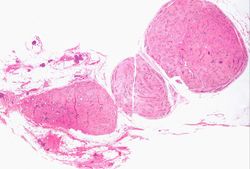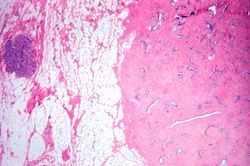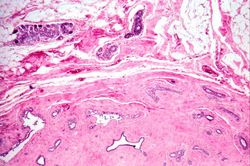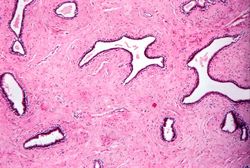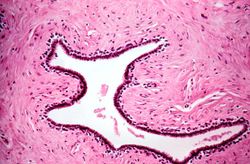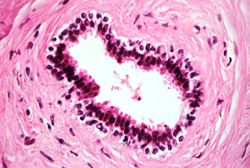Difference between revisions of "IPLab:Lab 7:Fibroadenoma"
Seung Park (talk | contribs) |
Seung Park (talk | contribs) |
||
| Line 12: | Line 12: | ||
File:IPLab7Fibroadenoma7.jpg|This is a higher magnification of fibroadenoma showing irregularly shaped ducts lined by two layers of cells as previously described. | File:IPLab7Fibroadenoma7.jpg|This is a higher magnification of fibroadenoma showing irregularly shaped ducts lined by two layers of cells as previously described. | ||
</gallery> | </gallery> | ||
| + | |||
| + | == Study Questions == | ||
| + | * <spoiler text="What tissue makes up the neoplastic portion of the fibroadenoma?">Fibroadenomas are new growths of glandular and stromal tissues. Cytogenetic studies have shown that in some cases only the fibrous (stromal) component is clonal. These tumors appear to arise from the specialized intralobular stroma.</spoiler> | ||
| + | * <spoiler text="At what age do fibroadenomas usually occur?">They occur at any age within the reproductive period of life, but they are somewhat more common before age 30.</spoiler> | ||
| + | * <spoiler text="Why do fibroadenomas cause problems in pre-menopausal women?">The epithelium of the fibroadenoma is responsive to hormones. Slight increases in size may occur during the late phases of each menstrual cycle, and pregnancy may stimulate growth and lactation. Postmenopausally, regression or calcification may result. There is also a slightly increased risk for development of breast carcinoma.</spoiler> | ||
{{IPLab 7}} | {{IPLab 7}} | ||
[[Category: IPLab:Lab 7]] | [[Category: IPLab:Lab 7]] | ||
Revision as of 15:24, 21 August 2013
Clinical Summary
Four months prior to admission, this 25-year-old female became aware of a lump beneath the areola of her right breast. Physical examination confirmed the presence of an approximately 3 cm movable, rubbery mass. An aspiration was attempted but did not yield any fluid or cells. At the time of surgical exploration, a well-circumscribed mass was identified and removed.
Images
This is a high magnification of the fibroadenoma showing the dense stroma of the tumor surrounding the irregularly shaped duct. The ducts are lined by two cell layers, one of cuboidal, two columnar cells (inner layer) and an outer layer of flattened cells with hyperchromatic nuclei (myoepithelial cells).
Study Questions
